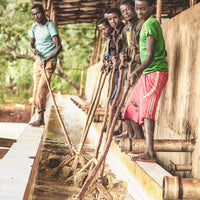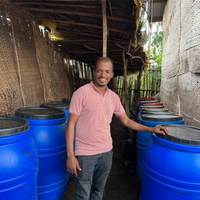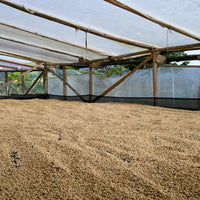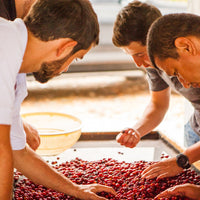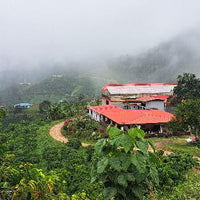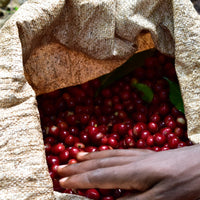Colombia Finca Napoles
Origin: Colombia
Region: Cauca
Sub Region: El Tambano
Altitude: 1820 meters above sea level
Farm: Finca Napoles
Owner: Raquel Fernandez Gonzalez
Variety: Castillo
Process: Washed
Tasting Notes: Sweet, clean and crisp with notes of red apple, cherry and honey.
A history of conflict and instability has made it difficult for coffee producers in Cauca to market their coffee as microlots. As the region becomes more accessible, Cauca’s high altitudes and ideal microclimates are establishing it as part of the “New Coffee Triangle.” These microlots from small producers working with CAFICAUCA (the Cooperativa de Caficultores del Cauca) demonstrate the incredible potential of Cauca’s coffee production.
Producers receive technical and financial assistance from CAFICAUCA. In addition to coffee, producers also cultivate beans, maize and plantains.
Farmers selectively handpick ripe cherry and process it on their farms. Some farmers lightly ferment cherry by leaving it in loosely-lidded boxes overnight before pulping. Once pulped, cherry is fermented in tanks and then washed in clean water. Parchment is laid in parabolic dryers covered with mesh that helps control drying temperature. Parchment is raked frequently to ensure even drying. It takes approximately 10 to 15 days for parchment to dry.
From their roots in 1961 with 297 coffee growers, the Cooperativa de Caficultores del Cauca (CAFICAUCA) has remained focused on economic empowerment for their members. Now, their more than 2,700 members, benefit from their value addition roasting business that captures a larger portion of a coffee’s final value and shares that extra income with producer-members.
In addition to their roasting business, the cooperative provides a plethora of services for its members and their coffee-growing communities. Producers can apply for loans, scholarships and aid from the cooperative as well as purchase fertilizers and other inputs at good prices.
Alongside Nariño and Huila, Cauca is becoming part of the “New Coffee Triangle.” Named after the Eje Cafetero, the region that was once the heart of Colombia’s coffee production, this New Coffee Triangle takes advantage of the high altitudes from the Andes Mountains and water-rich drainage basins that abound in the region.
Also like Nariño and Huila, Cauca is emerging from a long history of armed conflict and drug smuggling, which isolated the region and made it difficult to maintain coffee traceability.
In Cauca, most coffee is grown in small plots by rural and largely indigenous communities. More than 90,000 families cultivate approximately 93,000 hectares on coffee across Cauca. The most common varieties are Castillo, Colombia, Caturra, Typica, Bourbon and Tabí.
Colombia has been producing and exporting coffee renowned for their full body, bright acidity and rich aftertaste, since the early 19th century.
Colombia boasts a wide range of climates and geographic conditions that, in turn, produce their own unique flavors in coffee. This also means that harvest times can vary quite a bit. In fact, between all its different regions, Colombia produces fresh crop nearly all year round.
The increasing focus on the specialty industry is changing the way traders and farmers do business. It is becoming more common for farmers to isolate the highest quality beans in their lots to market separately. These higher quality lots are often sold under specific brands or stories.
Besides its wide variety of cup profiles, Colombia has quickly expanded its certification options over the past 10 years. The most common certifications available are Fairtrade, Rainforest Alliance, UTZ and Organic.
Although coffee production in Colombia did not become a large commercial industry until the 19th century, it is likely that coffee was introduced to Colombia about a century earlier by Jesuit priests.
Once commercial production started, it spread quickly. The first commercial coffee plantations were established in the east, near the border with Venezuela. Today, coffee is widespread and grown commercially in 20 of Colombia’s 32 Departments.
Historically, Colombia’s the most renowned coffee-growing region has been the Eje Cafetero (Coffee Axis), also known as the ‘Coffee Triangle’. This region includes the departments of Caldas, Quindío and Risaralda. With a combined total area of 13,873 km² (5356 mi²), the region covers about 1.2% of the Colombian territory and composes 15% of the total land planted under coffee in the country. The region has also been declared a UNESCO World Heritage site.
While the Eje Cafetero is still a coffee-producing power house, coffee production in Colombia now extends far beyond this zone. In recent years, the departments of Huila, Tolima, Cauca and Nariño have become sought after and well-known coffee growing regions. These departments rose to such prominence thanks, in part, to their high-scoring submissions in national and international cupping competitions, such as the Cup of Excellence.
Today, there are an estimated 540,000 coffee producers in the country; around 95% of these are smallholder farmers with landholdings that are under 5 hectares. These farmers collectively contribute around 16% of the country’s annual agricultural GDP.
Colombia boasts a wide range of microclimates and geographical conditions that produce the unique flavors so loved in Colombian coffees. While there are many sub-regions and progressively smaller geographical designations—all the way down to individual farms—broadly speaking, coffees in Colombia can be separated into three major regions whose climate, soils and altitudes affect tastes.
Coffees grown in the north (Magdalena, Casanare, Santander and Norte de Santander) are usually planted at lower altitudes where temperatures are higher. As such, these coffees tend to have deeper, earthier tastes with a medium acidity, more body and notes of nuts and chocolate.
Coffee coming from the central regions (Caldas, Quindío, Risaralda, North of Valle, Antioquia, Cundinamarca and North of Tolima) are celebrated for their overall balance and their fruity, herbal notes. Flavor variations highlight the specific characteristics of each micro-region.
The southern regions (Cauca, Nariño, Huila and South of Tolima) are prized for producing smooth coffees with high sweetness and citrus notes. They are also known for their medium body and more pronounced acidity.
Another distinguishing feature of Colombian coffee production is the mitaca crop – a second harvest that occurs roughly 6 months after the main crop in most regions. The mitaca crop is a result of moist ocean air rising from both the Pacific and the Caribbean and the north-to-south orientation of the central cordilleras (mountain ranges). Colombia is one of only a few countries in the world that has this feature of production.
Colombia’s wide range of climates also means that harvest times can vary significantly. Due to these varying harvest times—and the mitaca crop—fresh crop Colombian coffee is available nearly year round.
Most farmers conduct primary processing (pulping and drying) on their own farms. Processing infrastructure varies widely but there are noticeable similarities between farms of similar sizes or regions. Broadly speaking, most farms have traditionally used the Fully washed method and utilize dry pulping to minimize water usage.
Drying processes in Colombia are innovative and varied. Farmers may spread their parchment across the flat roofs (elvas) of their houses to dry slowly – sometimes in the shade but more often in the sun.
In parts of Antioquia, drying ‘drawers’ are used. These are sets of moveable drying screens that can be pulled out from under the house or storage sheds when the weather is warm and pushed back under shelter when it rains.
Polytunnels and parabolic beds are also commonly used, particularly in high altitude and cooler temperatures zones. These structures are usually raised beds constructed similarly to mini-greenhouses with plastic sheeting stretched over an arched frame and openings at both ends to ensure airflow. These structures protect parchment from wet weather conditions while the even airflow allows for drying even in humid conditions.
As Colombian farmers are increasingly accessing specialty markets, they are producing more Naturals and Honeys of exceptional quality. And these processes are not limited to a select few. Along with Naturals and Honeys, experimentally processed coffees are now coming from a variety of regions.
Colombia’s coffee industry has been incredibly successful at building a brand that continues to help increase interest and demand for Colombian coffee. Beyond simply increasing demand, the industry’s branding made advertising history. Their iconic coffee farmer, Juan Valdez and his donkey, Conchita, were extremely recognizable.
Juan was initially created in 1958 for Colombia’s Federación Nacional de Cafeteros (FNC) (the Federation of Colombian Coffee Growers) and his visage graces the FNC logo – along with countless of bags of Colombian coffee – to this day.
The story of Juan Valdez is just one example of the ways FNC has been a strong force in creating continuity for the reputation of Colombian coffee. Since its creation in 1927, the FNC has represented the interests of Colombia’s coffee growers. Their continued presence is almost unique in the coffee world and is, in part, one of the reasons that Colombia is such a powerhouse of coffee production.
Though originally a non-profit organization, today the FNC is collectively owned and controlled by approximately 540,000 producers across Colombia. In addition to cooking up genius marketing icons the FNC works to ensure adequate infrastructure for growers, provide technical support, and funds research. Their research division, Cenicafé (founded in 1938), is renowned for its focus on developing new genetic varieties and conducting research on improved farming practices.
The FNC also seeks price stabilization and ensures minimum pricing for Colombia’s coffee farmers. Despite this, labor shortages are a growing problem in the country, as young people move out of rural coffee-growing areas into the city. This situation is the ‘new normal’ for Colombian producers and the high cost of labor is one that is a risk for many and for the industry as a whole.
In addition to its wide variety of cup profiles, the popularity of certified coffee in Colombia has grown very quickly over the past ten years. The most common certifications are Fairtrade, Rainforest Alliance (RFA), UTZ, and Organic. Company certifications such as Starbucks C.A.F.E. Practices are also becoming more widespread.
The increasing focus on the specialty industry is changing the way traders and farmers do business. It is becoming more common for farmers to reserve their highest quality beans in order to market them separately, at higher prices. Often, they can sell these lots with more traceability information that will reach all the way to the end customers. For farmers, having their name and life story connected to their coffee, which is then purchased and seen by the end user, brings many benefits. It means that they can nurture long-term relationships with roasters and increase the value of their product. For roasters, connecting farmers’ stories to the coffees they grew can create a stronger customer interest for specific coffees, added value and demand, and help finance successful long-term relationships with farmers.


